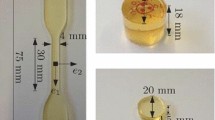Abstract
Time-dependent indentation creep behaviors of polydimethylsiloxane (PDMS) samples of different crosslink densities were studied through contact creep tests loaded with silica tips. Step loads from 0.1 to 10 mN were applied and held for 600 s. The data of penetration depth versus time were recorded during the holding period. A Hertz-type viscoelastic model was used to compute the creep compliance of the samples and the Johnson–Kendall–Roberts (JKR) theory was used to obtain the initial equivalent modulus, infinite equivalent modulus, and work of adhesion between the tested each pair of the PDMS and fused silica tip surfaces. The comparison between initial and infinite equivalent moduli obtained from the Hertz viscoelastic theory and the JKR theory shows that the adhesion between the tip and the sample surface plays an importance role in affecting the analysis results when the indentation strain is small. The influences of crosslink density, applied load, and tip size on the localized PDMS properties are discussed.








Similar content being viewed by others
References
Balakrisnan, B., Patil, S., Smela, E.: Patterning PDMS using a combination of wet and dry etching. J. Micromech. Microeng. 19(4), 047002 (2009)
Chambon, F., Winter, H.H.: Linear viscoelasticity at the gel point of a crosslinking PDMS with imbalanced stoichiometry. J. Rheol. 31(8), 683–697 (1987)
Hu, Y., Mackenzie, J.D.: Rubber-like elasticity of organically modified silicates. J. Mater. Sci. 27(16), 4415–4420 (1992)
Brown, X.Q., Ookawa, K., Wong, J.Y.: Evaluation of polydimethylsiloxane scaffolds with physiologically-relevant elastic moduli: interplay of substrate mechanics and surface chemistry effects on vascular smooth muscle cell response. Biomaterials 26(16), 3123–3129 (2005)
Carrillo, F., Gupta, S., Balooch, M., Marshall, S.J., Marshall, G.W., Pruitt, L., Puttlitz, C.M.: Nanoindentation of polydimethylsiloxane elastomers: effect of crosslinking, work of adhesion, and fluid environment on elastic modulus. J. Mater. Res. 20(10), 2820–2830 (2005)
Lim, Y.Y., Chaudhri, M.M.: Indentation of elastic solids with a rigid Vickers pyramidal indenter. Mech. Mater. 38(12), 1213–1228 (2006)
Lim, Y.Y., Chaudhri, M.M.: Indentation of elastic solids with rigid cones. Philos. Mag. 84(27), 2877–2903 (2004)
Sirghi, L., Rossi, F.: Adhesion and elasticity in nanoscale indentation. Appl. Phys. Lett. 89(24), 243118 (2006)
Deuschle, J.K., Deuschle, H.M., Enders, S., Arzt, E.: Contact area determination in indentation testing of elastomers. J. Mater. Res. 24(03), 736–748 (2011)
Song, J., Tranchida, D., Vancso, G.J.: Contact mechanics of UV/ozone-treated PDMS by AFM and JKR testing: mechanical performance from nano-to micrometer length scales. Macromolecules 41, 6757–6762 (2008)
Peng, X., Huang, J., Deng, H., Xiong, C., Fang, J.: A multi-sphere indentation method to determine Young’s modulus of soft polymeric materials based on the Johnson–Kendall–Roberts contact model. Meas. Sci. Technol. 22(2), 027003 (2011)
Shen, Y.X., Wei, P.J., Lin, J.F.: Modified method developed for contact-induced adhesion in indentation. J. Mater. Res. 24(05), 1795–1802 (2009)
Vanlandingham, M.R., Chang, N.K., Drzal, P.L., White, C.C., Chang, S.H.: Viscoelastic characterization of polymers using instrumented indentation. I. Quasi-static testing. J. Polym. Sci. B 43(14), 1794–1811 (2005)
Oliver, W.C., Pharr, G.M.: An improved technique for determining hardness and elastic modulus using load and displacement sensing indentation experiments. J. Mater. Res. 7(6), 1564–1583 (1992)
Lee, E.H., Radok, J.R.M.: The contact problem for viscoelastic bodies. J. Appl. Mech. 27, 438–444 (1960)
Cheng, Y.-T., Yang, F.: Obtaining shear relaxation modulus and creep compliance of linear viscoelastic materials from instrumented indentation using axisymmetric indenters of power-law profiles. J. Mater. Res. 24(10), 3013–3017 (2011)
Cheng, Y.-T., Cheng, C.-M.: Relationship between contact stiffness, contact depth, and mechanical properties for indentation in linear viscoelastic solids using axisymmetric indenters. Struct. Control Health Monit. 13(1), 561–569 (2006)
Lu, H., Wang, B., Ma, J., Huang, G., Viswanathan, H.: Measurement of creep compliance of solid polymers by nanoindentation. Mech. Time Depend. Mater. 7, 189–207 (2003)
Oyen, M.L.: Analytical techniques for indentation of viscoelastic materials. Philos. Mag. 86(33–35), 5625–5641 (2006)
Oyen, M.L., Cook, R.F.: Load–displacement behavior during sharp indentation of visco-elastic–plastic materials. J. Mater. Res. 18(1), 139–150 (2003)
Vandamme, M., Ulm, F.-J.: Viscoelastic solutions for conical indentation. Int. J. Solids Struct. 43(10), 3142–3165 (2006)
Liu, K., Vanlandingham, M.R., Ovaert, T.C.: Mechanical characterization of soft viscoelastic gels via indentation and optimization-based inverse finite element analysis. J. Mech. Behav. Biomed. Mater. 2(4), 355–363 (2009)
Ovaert, T.C., Kim, B.R., Wang, J.: Multi-parameter models of the viscoelastic/plastic mechanical properties of coatings via combined nanoindentation and non-linear finite element modeling. Prog. Org. Coat. 47(3–4), 312–323 (2003)
Wang, J., Ovaert, T.C.: Computational mechanical property determination of viscoelastic/plastic materials from nanoindentation creep test data. J. Mater. Res. 24(03), 1245–1257 (2011)
Hui, C.Y., Baney, J.M., Kramer, E.J.: Contact mechanics and adhesion of viscoelastic spheres. Langmuir 14, 6570–6578 (1998)
Johnson, K.L., Kendall, K., Roberts, A.D.: Surface energy and the contact of elastic solids. Proc. R. Soc. Lond. A 324, 301–313 (1971)
He, B., Lee, J., Patankar, N.A.: Contact angle hysteresis on rough hydrophobic surfaces. Colloids Surf. A 248(1–3), 101–104 (2004)
Mata, A., Fleischman, A.J., Roy, S.: Characterization of polydimethylsiloxane (PDMS) properties for biomedical micro nanosystems. Biomed. Microdevices 7(4), 281–293 (2005)
White, C.C., Vanlandingham, M.R., Drzal, P.L., Chang, N.K., Chang, S.H.: Viscoelastic characterization of polymers using instrumented indentation. II. Dynamic testing. J. Polym. Sci. B 43(14), 1812–1824 (2005)
Brinson, H.F., Brinson, L.C.: Polymer Engineering Science and Viscoelasticity. Cambridge University Press, Cambridge (2008)
Perutz, S., Kramer, E.J., Baney, J., Hui, C.-Y., Cohen, C.: Investigation of adhesion hysteresis in poly(dimethylsiloxane) networks using the JKR technique. J. Polym. Sci. B 36, 2129–2139 (1998)
Maxwell, R.S., Balazs, B.: Residual dipolar coupling for the assessment of cross-link density changes in γ-irradiated silica-PDMS composite materials. J. Chem. Phys. 116(23), 10492 (2002)
Tabor, D.: Microindentation Techniques in Materials Science and Engineering. American Society for Testing and Materials, Philadelphia (1986)
Galliano, A., Bistac, S., Schultz, J.: Adhesion and friction of PDMS networks: molecular weight effects. J. Colloid Interface Sci. 265(2), 372–379 (2003)
Author information
Authors and Affiliations
Corresponding author
Rights and permissions
About this article
Cite this article
Li, Z., Yu, H. & Wang, Q.J. Contact Creep Behavior of Polydimethylsiloxane and Influence of Load, Tip Size, and Crosslink Density. Tribol Lett 49, 291–299 (2013). https://doi.org/10.1007/s11249-012-0069-7
Received:
Accepted:
Published:
Issue Date:
DOI: https://doi.org/10.1007/s11249-012-0069-7




